
FAS Note: The proceedings of the Cardozo Law School Symposium on The Progressive Case were published in Cardozo Law Review, Vol 26, No 4, March 2005. Howard Morland's slide show on the quest to find the secret (law review pages 1366-1378) is posted below. His essay, "Born Secret," on legal and political aspects of H-Bomb technology (law review pages 1401-1408) is posted separately as a .pdf file (link), with the author's permission.
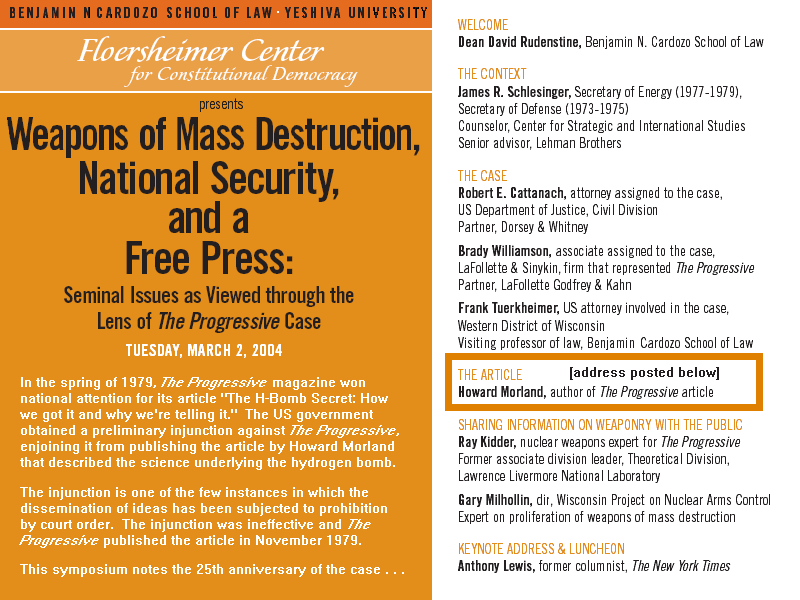 The Progressive case was more about images than text, so I will use a lot of images in my talk, including stage props.
My assignment is to answer the two questions on the magazine cover: The H-bomb secret - how we got, why we're telling it. I'll start with the why part.
The Progressive case was more about images than text, so I will use a lot of images in my talk, including stage props.
My assignment is to answer the two questions on the magazine cover: The H-bomb secret - how we got, why we're telling it. I'll start with the why part.
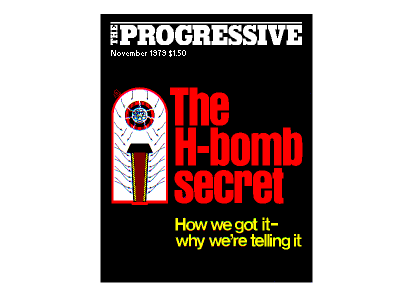 I'm a nuclear weapons abolitionist, for practical as well as moral reasons. I want my country to renounce nuclear weapons, unilaterally, and destroy its nuclear arsenal. We could then use all our political and economic power -- military if necessary -- to promote a world-wide ban on nuclear weapons.
Despite our present preoccupation with low-tech terrorism, nuclear weapons are still the only threat to our national security. I believe they are entirely useless to us, and we are unlikely eliminate their threat if we continue to operate from our present position of nuclear hypocrisy.
With opinions like that, I am precisely the type person the First Amendment was intended to protect: a political advocate whose ideas are unpopular with the general public and threatening to the government. But why tell the H-bomb secret?
In 1978, I was giving lectures to environmental activists who were protesting nuclear power. I wanted to call their attention to the bomb. To illustrate my lectures, I thought a model of a nuclear weapon, like the one beside me now, would be useful. I planned to open it like a book and reveal its secrets, describe its power, make it real.
For example, three nuclear warheads the size of this model could flatten Manhattan Island south of Central Park. Anything left standing would be a tall cinder; no people would survive. This small trash can is the actual size of a half-megaton warhead, and every Trident submarine carries a hundred of them. A visual aid like this would help demystify the bomb, show it to be a product of industry, an assemblage of components. That was the first why: to promote nuclear disarmament, visually.
When it came time to tell the secret, The Progressive's editors and I were confident that, reason two, it would cause no harm, and, reason three, the First Amendment would protect us from draconian punishment.
Speaking of punishment, on easels at the front of the room I have a story from the Sunday Times of London, October 1986. It's an article on the Israeli nuclear arsenal, written with information provided by Israeli bomb technician Mordechai Vanunu. His punishment for those three pages of newsprint was eleven years in solitary confinement at Ashkelon Prison in Israel; his eighteen year sentence ends next month. In this country, with its tradition of free speech, supported by the constitution, we didn't expect that sort of thing to happen to us, or to any of our sources.
I mention Vanunu in part as a tribute to the late Sam Day, the editor who hired me for The Progressive assignment. The plight of Mordechai Vanunu was Sam's final crusade.
I'm a nuclear weapons abolitionist, for practical as well as moral reasons. I want my country to renounce nuclear weapons, unilaterally, and destroy its nuclear arsenal. We could then use all our political and economic power -- military if necessary -- to promote a world-wide ban on nuclear weapons.
Despite our present preoccupation with low-tech terrorism, nuclear weapons are still the only threat to our national security. I believe they are entirely useless to us, and we are unlikely eliminate their threat if we continue to operate from our present position of nuclear hypocrisy.
With opinions like that, I am precisely the type person the First Amendment was intended to protect: a political advocate whose ideas are unpopular with the general public and threatening to the government. But why tell the H-bomb secret?
In 1978, I was giving lectures to environmental activists who were protesting nuclear power. I wanted to call their attention to the bomb. To illustrate my lectures, I thought a model of a nuclear weapon, like the one beside me now, would be useful. I planned to open it like a book and reveal its secrets, describe its power, make it real.
For example, three nuclear warheads the size of this model could flatten Manhattan Island south of Central Park. Anything left standing would be a tall cinder; no people would survive. This small trash can is the actual size of a half-megaton warhead, and every Trident submarine carries a hundred of them. A visual aid like this would help demystify the bomb, show it to be a product of industry, an assemblage of components. That was the first why: to promote nuclear disarmament, visually.
When it came time to tell the secret, The Progressive's editors and I were confident that, reason two, it would cause no harm, and, reason three, the First Amendment would protect us from draconian punishment.
Speaking of punishment, on easels at the front of the room I have a story from the Sunday Times of London, October 1986. It's an article on the Israeli nuclear arsenal, written with information provided by Israeli bomb technician Mordechai Vanunu. His punishment for those three pages of newsprint was eleven years in solitary confinement at Ashkelon Prison in Israel; his eighteen year sentence ends next month. In this country, with its tradition of free speech, supported by the constitution, we didn't expect that sort of thing to happen to us, or to any of our sources.
I mention Vanunu in part as a tribute to the late Sam Day, the editor who hired me for The Progressive assignment. The plight of Mordechai Vanunu was Sam's final crusade.
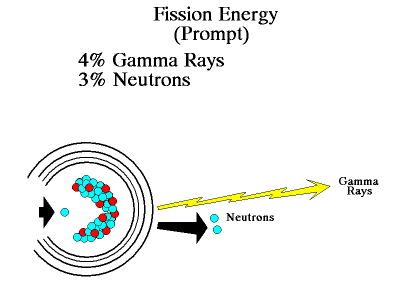
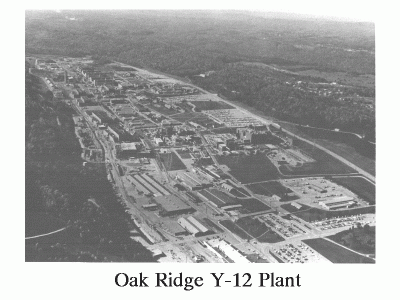
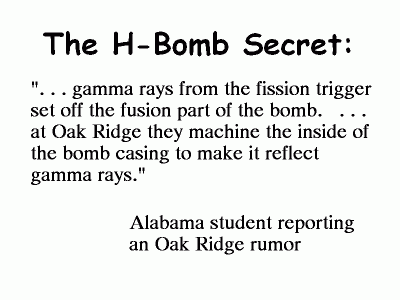 There is a fourth answer to the "why" question which I will mention later.
How did I get the secret?
In January of 1978, while speaking to a physics seminar at the University of Alabama in Tuscaloosa, I asked if anybody knew the H-bomb secret. A student from Oak Ridge, Tennessee, answered, "gamma rays from the fission trigger set off the fusion part of the bomb. . . .at Oak Ridge they machine the inside of the bomb casing to make it reflect gamma rays."
In journalism they say, "Your mom says she loves you? Check it out." One part checked out. I learned that Oak Ridge has the nation's largest H-bomb component factory: the Y-12 plant.
I looked up "fission" in the encyclopedia and found that gamma rays are the first form of energy produced by fission. They're only four percent of the total energy, but four percent of a large number can still be a large number. Lawyers don't understand this fact, which is why they charge thirty-three percent. Real estate people have a better understanding of how to get rich on small percentages.
Neutrons carry off another three percent. They sustain the chain reaction, but when that finishes there are lots of spare neutrons flying around.
There is a fourth answer to the "why" question which I will mention later.
How did I get the secret?
In January of 1978, while speaking to a physics seminar at the University of Alabama in Tuscaloosa, I asked if anybody knew the H-bomb secret. A student from Oak Ridge, Tennessee, answered, "gamma rays from the fission trigger set off the fusion part of the bomb. . . .at Oak Ridge they machine the inside of the bomb casing to make it reflect gamma rays."
In journalism they say, "Your mom says she loves you? Check it out." One part checked out. I learned that Oak Ridge has the nation's largest H-bomb component factory: the Y-12 plant.
I looked up "fission" in the encyclopedia and found that gamma rays are the first form of energy produced by fission. They're only four percent of the total energy, but four percent of a large number can still be a large number. Lawyers don't understand this fact, which is why they charge thirty-three percent. Real estate people have a better understanding of how to get rich on small percentages.
Neutrons carry off another three percent. They sustain the chain reaction, but when that finishes there are lots of spare neutrons flying around.
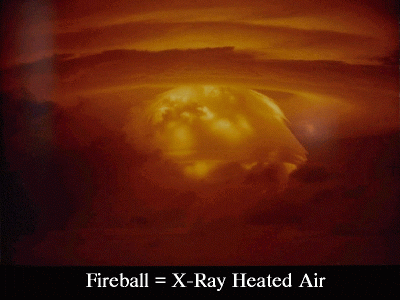
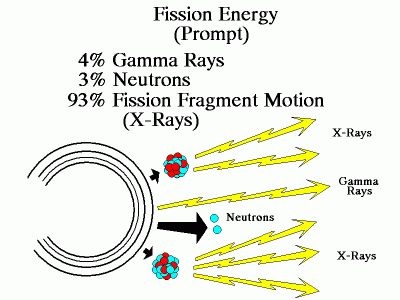 Ninety-three percent of fission energy is in the form of fission fragment motion, which I assumed would be less useful because I overlooked the fact that all that energy would quickly become x-ray energy via the bremsstrahlung effect. I was aware that a nuclear fireball is essentially x-ray heated air, but I didn't realize the x-rays would develop soon enough to dominate events inside the bomb casing, as well as the surrounding countryside.
In my ignorance, I assumed the coupling energy between the fission bomb and the fusion bomb would be either gamma rays or neutrons.
Ninety-three percent of fission energy is in the form of fission fragment motion, which I assumed would be less useful because I overlooked the fact that all that energy would quickly become x-ray energy via the bremsstrahlung effect. I was aware that a nuclear fireball is essentially x-ray heated air, but I didn't realize the x-rays would develop soon enough to dominate events inside the bomb casing, as well as the surrounding countryside.
In my ignorance, I assumed the coupling energy between the fission bomb and the fusion bomb would be either gamma rays or neutrons.
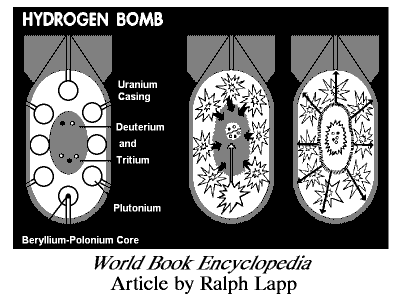
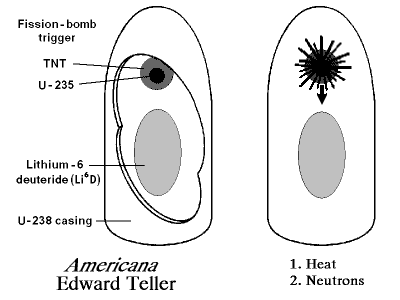 I looked up "H-bomb" in two encyclopedias, World Book and Americana. The World Book article was written by Ralph Lapp, who did not know the secret in spite of having published more words on the H-bomb than anybody else. His article was accompanied by unsigned drawings of obscure origin, which Lapp had never seen. They showed hydrogen fusion fuel -- tritium and deuterium -- surrounded by exploding plutonium fission bombs. This would obviously work, but there was no mechanism to compress, or implode, all those fission bombs and set them off, unless the entire bomb was somehow to be imploded.
The Americana article was by Edward Teller, father of the H-bomb, and its unsigned drawings were likewise not from the author. The Americana scheme showed a fission and a fusion bomb inside an otherwise empty uranium bottle. This arrangement was consistent with the gamma ray idea, but the drawing was too simple to be the whole story. For example, the neutrons from the fission trigger were needed to convert lithium-6 into tritium for fusion, but the heat (i.e., gamma rays, I thought) would get there first and disperse the fusion fuel before the lithium was converted.
I later learned that the fission bomb trigger in this drawing is called the "primary" and the lithium deuteride charge is called the "secondary." Knowing those terms would have told me that this drawing is basically correct.
My resources included interviews with five luminaries, none of whom was both helpful and knew the secret. Ralph Lapp and Philip Morrison were both Manhattan Project veterans who quit the business before the H-bomb was developed in 1950. Morrison, who was willing to spend hours with me in his MIT office, reported that Herb York had once told him he could figure out the secret if he spent a year thinking about it. York himself met with me several times at a Pentagon City restaurant. He seemed amused by my interest in H-bombs but warned me not to try to build one. Teller was on record in favor of declassifying the whole thing, but when he learned I wanted to ban the bomb he identified me as his political enemy and made vague threats against me.
I looked up "H-bomb" in two encyclopedias, World Book and Americana. The World Book article was written by Ralph Lapp, who did not know the secret in spite of having published more words on the H-bomb than anybody else. His article was accompanied by unsigned drawings of obscure origin, which Lapp had never seen. They showed hydrogen fusion fuel -- tritium and deuterium -- surrounded by exploding plutonium fission bombs. This would obviously work, but there was no mechanism to compress, or implode, all those fission bombs and set them off, unless the entire bomb was somehow to be imploded.
The Americana article was by Edward Teller, father of the H-bomb, and its unsigned drawings were likewise not from the author. The Americana scheme showed a fission and a fusion bomb inside an otherwise empty uranium bottle. This arrangement was consistent with the gamma ray idea, but the drawing was too simple to be the whole story. For example, the neutrons from the fission trigger were needed to convert lithium-6 into tritium for fusion, but the heat (i.e., gamma rays, I thought) would get there first and disperse the fusion fuel before the lithium was converted.
I later learned that the fission bomb trigger in this drawing is called the "primary" and the lithium deuteride charge is called the "secondary." Knowing those terms would have told me that this drawing is basically correct.
My resources included interviews with five luminaries, none of whom was both helpful and knew the secret. Ralph Lapp and Philip Morrison were both Manhattan Project veterans who quit the business before the H-bomb was developed in 1950. Morrison, who was willing to spend hours with me in his MIT office, reported that Herb York had once told him he could figure out the secret if he spent a year thinking about it. York himself met with me several times at a Pentagon City restaurant. He seemed amused by my interest in H-bombs but warned me not to try to build one. Teller was on record in favor of declassifying the whole thing, but when he learned I wanted to ban the bomb he identified me as his political enemy and made vague threats against me.
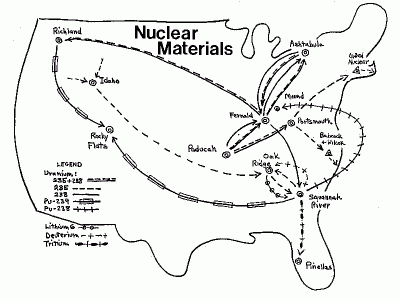
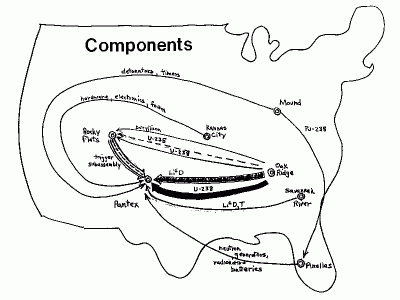
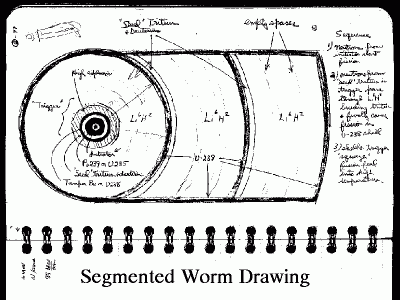 George Rathjens is noteworthy in this list. For years he had challenged his political science graduate students at MIT to figure out the secret, and none had done it. I was not enrolled in his program, but I accepted his challenge. More about Rathjens later.
I had many printed resources and, finally, in the spring of 1978, an unexpected assignment from The Progressive magazine to visit the H-bomb factories and take the unclassified guided tours. With a $500 travel allowance, I managed to see six of the seven component factories -- all but the final assembly plant in Amarillo, Texas-- and learn everything about them except what they make. For that part, I was still on my own.
On a swing through Boston, I showed my "Segmented Worm" drawing to Professor Rathjens. He said, "I don't think this will work."
George Rathjens is noteworthy in this list. For years he had challenged his political science graduate students at MIT to figure out the secret, and none had done it. I was not enrolled in his program, but I accepted his challenge. More about Rathjens later.
I had many printed resources and, finally, in the spring of 1978, an unexpected assignment from The Progressive magazine to visit the H-bomb factories and take the unclassified guided tours. With a $500 travel allowance, I managed to see six of the seven component factories -- all but the final assembly plant in Amarillo, Texas-- and learn everything about them except what they make. For that part, I was still on my own.
On a swing through Boston, I showed my "Segmented Worm" drawing to Professor Rathjens. He said, "I don't think this will work."
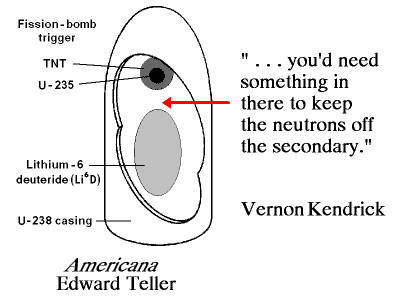
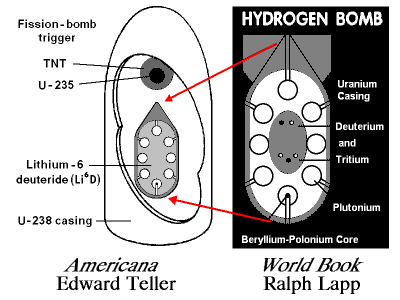
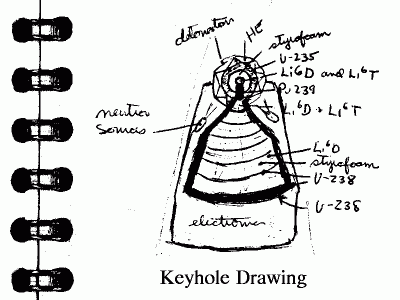 My next hypothesis was the "Keyhole" drawing, which used a plutonium spark plug to bridge the gap between the primary and secondary. My first chance to show it to anyone was November 1978 in Los Alamos. I had finished interviewing a Manhattan Project veteran about his work on wartime criticality experiments. I started to pull out the keyhole drawing, but thinking it was probably wrong anyway, I showed him the Teller Americana drawing instead. Lucky choice. I asked if he could add some detail to it, so I could trace the components back to their factories.
He pointed to the space between the primary and the secondary and said, "you'd need something in there to keep the neutrons off the secondary."
Bingo. It all came to me in a flash. Of course! It's gamma rays, after all. While he looked at the Teller Americana drawing, I was holding the Lapp World Book drawing. If the fins were removed, it became a uranium bottle with a pyramid of uranium at the top, a neutron blocker. If I used the Lapp bomb as a secondary for the Teller bomb, I would have a bottle within a bottle. The outer bottle would fill up with gamma rays.
My next hypothesis was the "Keyhole" drawing, which used a plutonium spark plug to bridge the gap between the primary and secondary. My first chance to show it to anyone was November 1978 in Los Alamos. I had finished interviewing a Manhattan Project veteran about his work on wartime criticality experiments. I started to pull out the keyhole drawing, but thinking it was probably wrong anyway, I showed him the Teller Americana drawing instead. Lucky choice. I asked if he could add some detail to it, so I could trace the components back to their factories.
He pointed to the space between the primary and the secondary and said, "you'd need something in there to keep the neutrons off the secondary."
Bingo. It all came to me in a flash. Of course! It's gamma rays, after all. While he looked at the Teller Americana drawing, I was holding the Lapp World Book drawing. If the fins were removed, it became a uranium bottle with a pyramid of uranium at the top, a neutron blocker. If I used the Lapp bomb as a secondary for the Teller bomb, I would have a bottle within a bottle. The outer bottle would fill up with gamma rays.

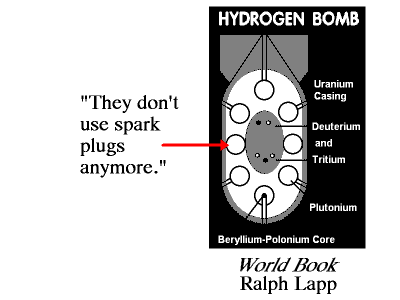
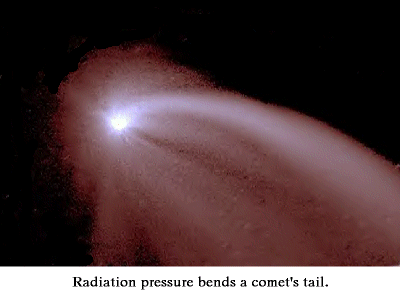 I recalled that radiation pressure bends the tail of a comet.
I knew the Lapp World Book bomb needed to be imploded to set off its plutonium triggers, and radiation pressure inside the outer bottle could do the job. That was the secret. Gamma rays and radiation pressure.
Barely containing my excitement, I showed him the other drawing and suggested it might make a good secondary. He pointed to the plutonium balls and replied, "They don't use spark plugs anymore." So they, too, have a name.
I recalled that radiation pressure bends the tail of a comet.
I knew the Lapp World Book bomb needed to be imploded to set off its plutonium triggers, and radiation pressure inside the outer bottle could do the job. That was the secret. Gamma rays and radiation pressure.
Barely containing my excitement, I showed him the other drawing and suggested it might make a good secondary. He pointed to the plutonium balls and replied, "They don't use spark plugs anymore." So they, too, have a name.
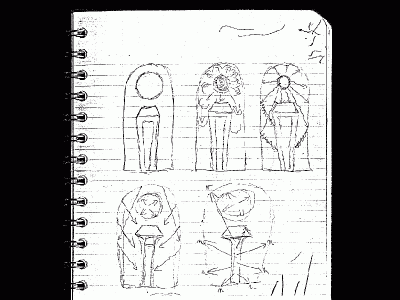
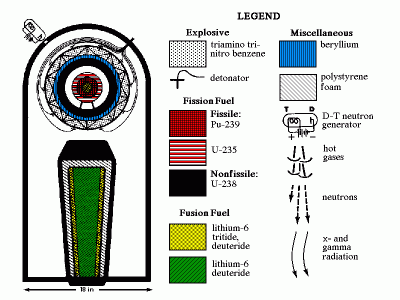
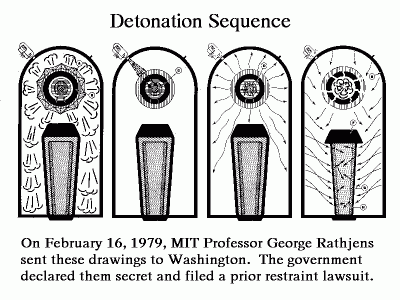 I went back to my sketchbook, and by December I had a drawing suitable for publication in The Progressive. In January, I sent it along with a manuscript to Sam Day. In February, I learned that Sam had sent a copy of the drawings to George Rathjens at MIT, who had sent them to Washington for classification. Apparently, I had earned a passing grade on the Rathjens challenge, but at the potential cost of losing my right to tell the story.
In response to my alarm, Sam and editor Erwin Knoll promised to fight any censorship all the way to the Supreme Court, and to defy the court in the end if they lost. They would cover all my legal expenses. It would make a great test case, they said. With some apprehension, I signed on as a First Amendment defendant. John Scopes, the evolution teacher in the Tennessee monkey trial, had been one of my childhood heroes.
That was the fourth "why:" to provoke a test case and challenge the constitutionality of the Atomic Energy Act.
I went back to my sketchbook, and by December I had a drawing suitable for publication in The Progressive. In January, I sent it along with a manuscript to Sam Day. In February, I learned that Sam had sent a copy of the drawings to George Rathjens at MIT, who had sent them to Washington for classification. Apparently, I had earned a passing grade on the Rathjens challenge, but at the potential cost of losing my right to tell the story.
In response to my alarm, Sam and editor Erwin Knoll promised to fight any censorship all the way to the Supreme Court, and to defy the court in the end if they lost. They would cover all my legal expenses. It would make a great test case, they said. With some apprehension, I signed on as a First Amendment defendant. John Scopes, the evolution teacher in the Tennessee monkey trial, had been one of my childhood heroes.
That was the fourth "why:" to provoke a test case and challenge the constitutionality of the Atomic Energy Act.
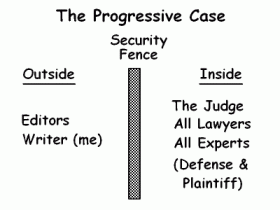
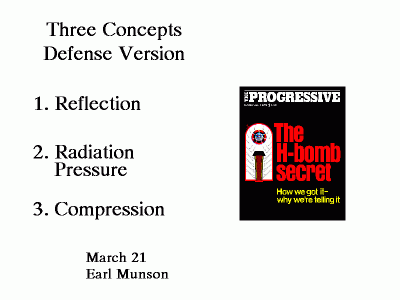
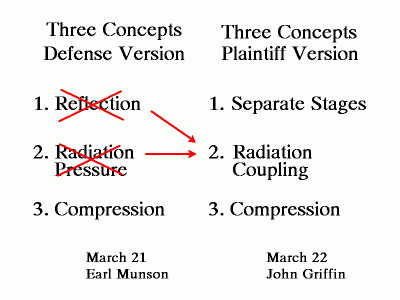 Because we chose not to seek security clearances, the case soon put the editors and me on the outside of a security fence, separating us from our own lawyers, who then became potential sources of information for me.
It got interesting right away.
In a secret, in camera, brief submitted on March 21, defense lawyer Earl Munson stated, "As near as we can tell," -- that's a Midwestern legal phrase -- "there are three concepts in the Morland article which the plaintiff contends are 'Restricted Data.'" He listed them as reflection, radiation pressure and compression. All three are illustrated on the magazine cover.
The next day, John Griffin, the Energy Department's classification specialist, accepted the three-concepts idea, but offered his own three concepts: separation of stages, which Munson did not think was secret; radiation coupling, which combined my erroneous descriptions of reflection and radiation pressure into something more vague and thus more accurate; and compression, which Griffin accepted without change.
These three concepts then became the core of the case. I first learned about them in September, after the case was dropped, when I read redacted versions of the in camera documents and hearing transcripts. In the meantime, I picked up on the notion that errors in my description of the H-bomb were a key feature of the case.
Because we chose not to seek security clearances, the case soon put the editors and me on the outside of a security fence, separating us from our own lawyers, who then became potential sources of information for me.
It got interesting right away.
In a secret, in camera, brief submitted on March 21, defense lawyer Earl Munson stated, "As near as we can tell," -- that's a Midwestern legal phrase -- "there are three concepts in the Morland article which the plaintiff contends are 'Restricted Data.'" He listed them as reflection, radiation pressure and compression. All three are illustrated on the magazine cover.
The next day, John Griffin, the Energy Department's classification specialist, accepted the three-concepts idea, but offered his own three concepts: separation of stages, which Munson did not think was secret; radiation coupling, which combined my erroneous descriptions of reflection and radiation pressure into something more vague and thus more accurate; and compression, which Griffin accepted without change.
These three concepts then became the core of the case. I first learned about them in September, after the case was dropped, when I read redacted versions of the in camera documents and hearing transcripts. In the meantime, I picked up on the notion that errors in my description of the H-bomb were a key feature of the case.
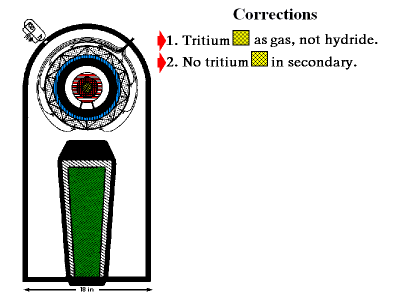
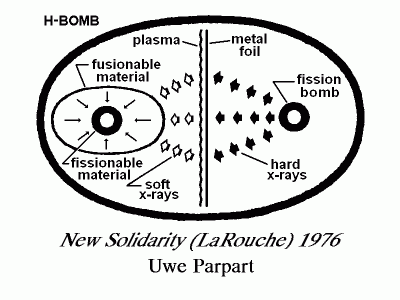
 I started a list of potential corrections.
The first correction came with an article in Economist magazine which pointed out that the tritium booster charge was deployed in gaseous, not hydride form. If that was true, the lithium tritide in my secondary was wrong, so I took it out.
Next, an anonymous envelope arrived from the Naval Research Laboratory in Washington, containing a 1976 clipping from New Solidarity newspaper, a free tabloid handed out at airports by Lyndon La Rouche's zombie-like followers. The article, by one Uwe Parpart, included an H-bomb diagram similar to mine, but with x- not gamma rays driving the implosion and a fissionable spark plug in the secondary. The anonymous leaker vouched for the accuracy of this diagram, so I put the spark plug back in my own diagram.
I started a list of potential corrections.
The first correction came with an article in Economist magazine which pointed out that the tritium booster charge was deployed in gaseous, not hydride form. If that was true, the lithium tritide in my secondary was wrong, so I took it out.
Next, an anonymous envelope arrived from the Naval Research Laboratory in Washington, containing a 1976 clipping from New Solidarity newspaper, a free tabloid handed out at airports by Lyndon La Rouche's zombie-like followers. The article, by one Uwe Parpart, included an H-bomb diagram similar to mine, but with x- not gamma rays driving the implosion and a fissionable spark plug in the secondary. The anonymous leaker vouched for the accuracy of this diagram, so I put the spark plug back in my own diagram.
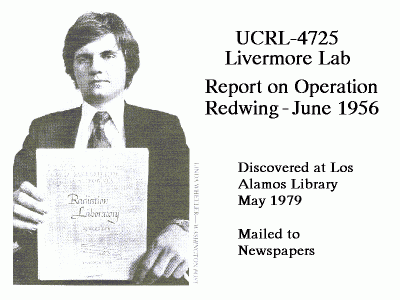
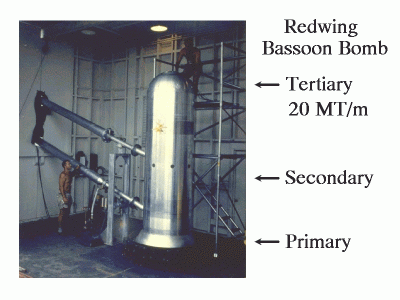
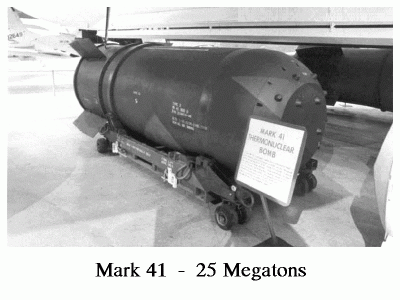 Then in May, a researcher working for the American Civil Liberties Union discovered UCRL-4725, a Livermore Lab report on Operation Redwing, June 1956. It was sitting on an open shelf at the Los Alamos Library; he mailed copies to newspapers. It contained no drawings or explanations, only cryptic references to design concepts and test results, but the event made headlines and prompted another round of political cartoons.
Most of the document concerned a three-stage device called Bassoon which was tested twice during Redwing. Its third, or tertiary, stage was rated at twenty megatons per meter; that's a megaton for every two inches of length. I've mentioned what three half-megaton bombs would do to Manhattan Island. Bassoon was later deployed as the twenty-five megaton Mark-41 bomb. We actually had these things flying around in the 1950's, fully assembled and ready to drop.
They have long since been retired in favor of smaller bombs.
Then in May, a researcher working for the American Civil Liberties Union discovered UCRL-4725, a Livermore Lab report on Operation Redwing, June 1956. It was sitting on an open shelf at the Los Alamos Library; he mailed copies to newspapers. It contained no drawings or explanations, only cryptic references to design concepts and test results, but the event made headlines and prompted another round of political cartoons.
Most of the document concerned a three-stage device called Bassoon which was tested twice during Redwing. Its third, or tertiary, stage was rated at twenty megatons per meter; that's a megaton for every two inches of length. I've mentioned what three half-megaton bombs would do to Manhattan Island. Bassoon was later deployed as the twenty-five megaton Mark-41 bomb. We actually had these things flying around in the 1950's, fully assembled and ready to drop.
They have long since been retired in favor of smaller bombs.
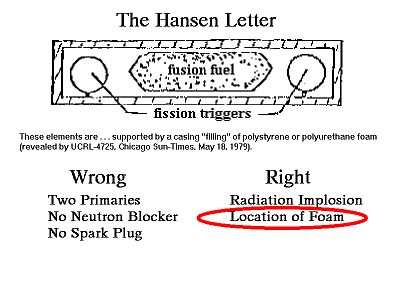
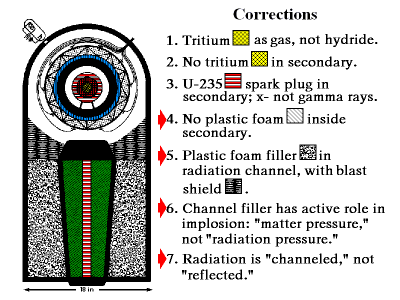 The government argued that UCRL-4725 did not reveal the H-bomb secret and that a reader would need my article as a guide to understanding it. Legally, it was a "let's see if the judge'll buy this one" type of argument. It worked, and the injunction held for another four months.
One thing I learned from the document was that the exotic plastic foam, which is made at the Kansas City plant, goes outside the secondary not inside, so I made that change in the drawing. At first, I thought the plastic was just a packaging material, but, in August, Chuck Hansen circulated an open letter to Senator Percy of Illinois, which outlined his speculations about the H-bomb secret.
The Hansen letter contained a number of obvious errors: two primaries, which would never work because of timing issues; no neutron blocker; and no spark plug. It did give a vague explanation of radiation implosion, and he got the location of the plastic foam right. To accompany his very crude drawing, Hansen included the following line of text: "These elements are supported by a casing filling of polystyrene or polyethylene foam (revealed by UCRL-4725, Chicago Sun Times, May 18, 1979)." Hansen identified the foam as a packaging item, as I did, but I soon learned that defense experts were making a big deal about the location of the foam. I suspected it was more than packaging.
To everyone's surprise, the government took the Hansen letter as an excuse to throw in the towel, declare the case moot, and give the go-ahead for publication of my article.
From redacted court documents, I learned that the plastic foam plays an active role in radiation implosion, and, finally, that radiation is "channeled" not "reflected."
Thus, all my thoughts about gamma rays, reflection, and radiation pressure -- which the government had tried to suppress -- were wrong anyway. My list of significant corrections was published as a full-page Errata in The Progressive one month after the unaltered article came out in the November 1979 issue.
The government argued that UCRL-4725 did not reveal the H-bomb secret and that a reader would need my article as a guide to understanding it. Legally, it was a "let's see if the judge'll buy this one" type of argument. It worked, and the injunction held for another four months.
One thing I learned from the document was that the exotic plastic foam, which is made at the Kansas City plant, goes outside the secondary not inside, so I made that change in the drawing. At first, I thought the plastic was just a packaging material, but, in August, Chuck Hansen circulated an open letter to Senator Percy of Illinois, which outlined his speculations about the H-bomb secret.
The Hansen letter contained a number of obvious errors: two primaries, which would never work because of timing issues; no neutron blocker; and no spark plug. It did give a vague explanation of radiation implosion, and he got the location of the plastic foam right. To accompany his very crude drawing, Hansen included the following line of text: "These elements are supported by a casing filling of polystyrene or polyethylene foam (revealed by UCRL-4725, Chicago Sun Times, May 18, 1979)." Hansen identified the foam as a packaging item, as I did, but I soon learned that defense experts were making a big deal about the location of the foam. I suspected it was more than packaging.
To everyone's surprise, the government took the Hansen letter as an excuse to throw in the towel, declare the case moot, and give the go-ahead for publication of my article.
From redacted court documents, I learned that the plastic foam plays an active role in radiation implosion, and, finally, that radiation is "channeled" not "reflected."
Thus, all my thoughts about gamma rays, reflection, and radiation pressure -- which the government had tried to suppress -- were wrong anyway. My list of significant corrections was published as a full-page Errata in The Progressive one month after the unaltered article came out in the November 1979 issue.
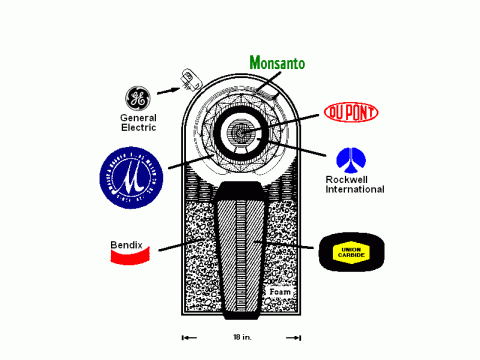
 With the corrected diagram, I now had what I needed to build the stage prop and to connect the components to the appropriate corporate logos. Within a few years, grassroots activists had driven all the H-bomb contractors out of the business, forcing the Energy Department to find new contractors to run its factories. One of the factories, the Rockwell-operated Rocky Flats plant near Denver, has been shut down for good, effectively shutting down the production line.
We haven't banned the bomb yet, but we do have this tangible result of the exercise of free speech by citizens.
With the corrected diagram, I now had what I needed to build the stage prop and to connect the components to the appropriate corporate logos. Within a few years, grassroots activists had driven all the H-bomb contractors out of the business, forcing the Energy Department to find new contractors to run its factories. One of the factories, the Rockwell-operated Rocky Flats plant near Denver, has been shut down for good, effectively shutting down the production line.
We haven't banned the bomb yet, but we do have this tangible result of the exercise of free speech by citizens.
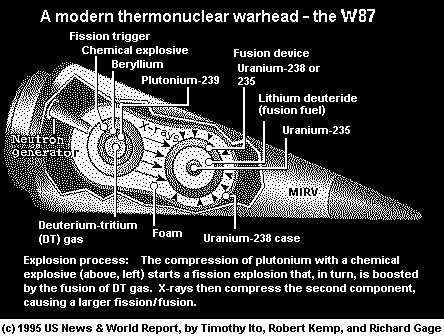
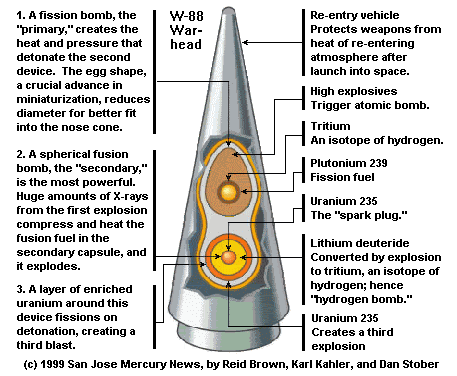
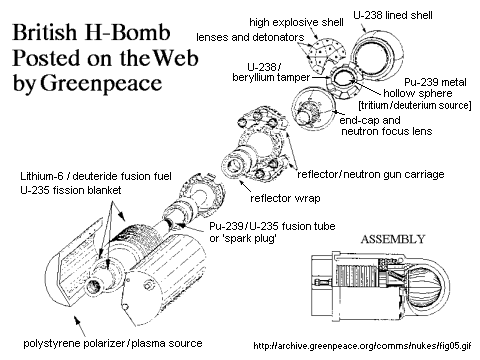 In the meantime, journalists and activists have continued to publish illustrated explanations of how H-bombs work, such as: U.S. News and World Report in 1995, the San Jose Mercury News in 1999, and Greenpeace on its website.
The Greenpeace drawing is unique. Every other drawing in this presentation originates outside the secrecy wall, as some artist's attempt to illustrate a concept. The Greenpeace drawing is said to come from a British nuclear weapons manual and to depict an actual weapon. Activists like to treat drawings like this in the spirit of a "wanted" poster. If you see one of these, call a weapons inspector. Do not attempt to make a citizen's arrest.
In the meantime, journalists and activists have continued to publish illustrated explanations of how H-bombs work, such as: U.S. News and World Report in 1995, the San Jose Mercury News in 1999, and Greenpeace on its website.
The Greenpeace drawing is unique. Every other drawing in this presentation originates outside the secrecy wall, as some artist's attempt to illustrate a concept. The Greenpeace drawing is said to come from a British nuclear weapons manual and to depict an actual weapon. Activists like to treat drawings like this in the spirit of a "wanted" poster. If you see one of these, call a weapons inspector. Do not attempt to make a citizen's arrest.
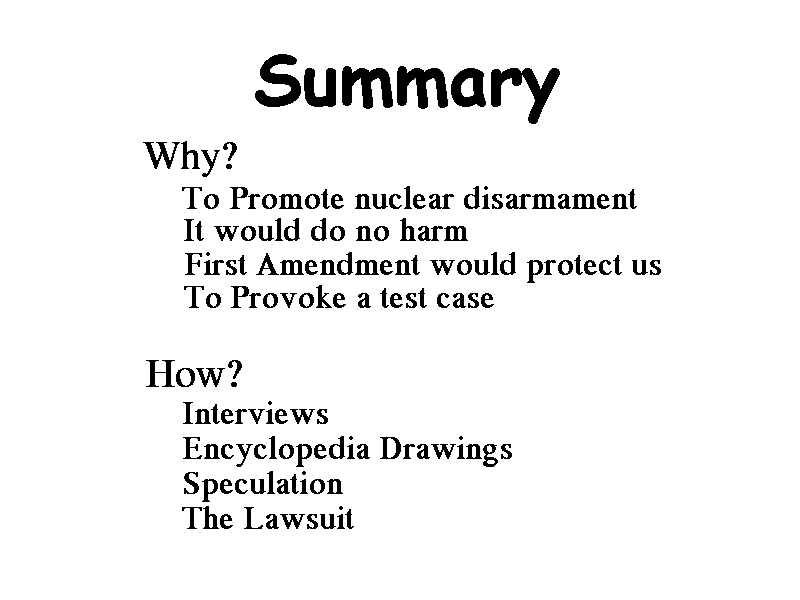
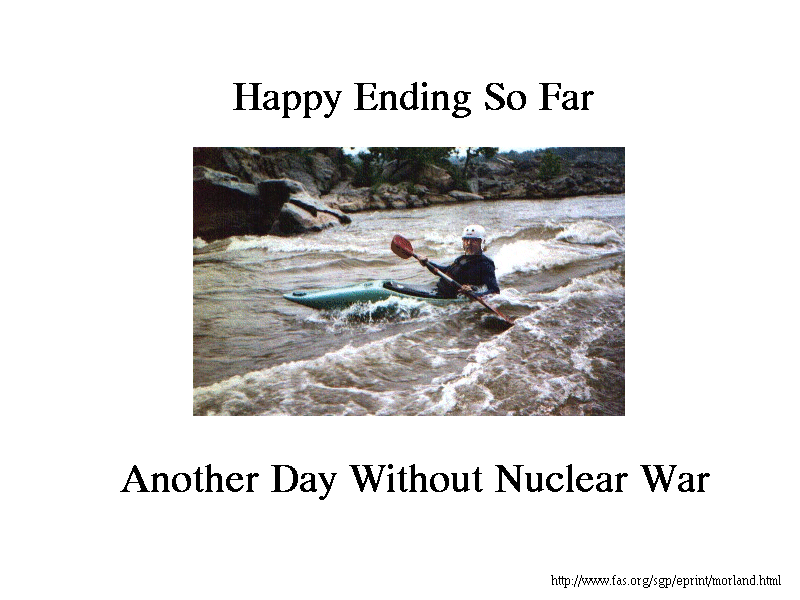






 There is a fourth answer to the "why" question which I will mention later.
How did I get the secret?
In January of 1978, while speaking to a physics seminar at the University of Alabama in Tuscaloosa, I asked if anybody knew the H-bomb secret. A student from Oak Ridge, Tennessee, answered, "gamma rays from the fission trigger set off the fusion part of the bomb. . . .at Oak Ridge they machine the inside of the bomb casing to make it reflect gamma rays."
In journalism they say, "Your mom says she loves you? Check it out." One part checked out. I learned that Oak Ridge has the nation's largest H-bomb component factory: the Y-12 plant.
I looked up "fission" in the encyclopedia and found that gamma rays are the first form of energy produced by fission. They're only four percent of the total energy, but four percent of a large number can still be a large number. Lawyers don't understand this fact, which is why they charge thirty-three percent. Real estate people have a better understanding of how to get rich on small percentages.
Neutrons carry off another three percent. They sustain the chain reaction, but when that finishes there are lots of spare neutrons flying around.
There is a fourth answer to the "why" question which I will mention later.
How did I get the secret?
In January of 1978, while speaking to a physics seminar at the University of Alabama in Tuscaloosa, I asked if anybody knew the H-bomb secret. A student from Oak Ridge, Tennessee, answered, "gamma rays from the fission trigger set off the fusion part of the bomb. . . .at Oak Ridge they machine the inside of the bomb casing to make it reflect gamma rays."
In journalism they say, "Your mom says she loves you? Check it out." One part checked out. I learned that Oak Ridge has the nation's largest H-bomb component factory: the Y-12 plant.
I looked up "fission" in the encyclopedia and found that gamma rays are the first form of energy produced by fission. They're only four percent of the total energy, but four percent of a large number can still be a large number. Lawyers don't understand this fact, which is why they charge thirty-three percent. Real estate people have a better understanding of how to get rich on small percentages.
Neutrons carry off another three percent. They sustain the chain reaction, but when that finishes there are lots of spare neutrons flying around.

 Ninety-three percent of fission energy is in the form of fission fragment motion, which I assumed would be less useful because I overlooked the fact that all that energy would quickly become x-ray energy via the bremsstrahlung effect. I was aware that a nuclear fireball is essentially x-ray heated air, but I didn't realize the x-rays would develop soon enough to dominate events inside the bomb casing, as well as the surrounding countryside.
In my ignorance, I assumed the coupling energy between the fission bomb and the fusion bomb would be either gamma rays or neutrons.
Ninety-three percent of fission energy is in the form of fission fragment motion, which I assumed would be less useful because I overlooked the fact that all that energy would quickly become x-ray energy via the bremsstrahlung effect. I was aware that a nuclear fireball is essentially x-ray heated air, but I didn't realize the x-rays would develop soon enough to dominate events inside the bomb casing, as well as the surrounding countryside.
In my ignorance, I assumed the coupling energy between the fission bomb and the fusion bomb would be either gamma rays or neutrons.

 I looked up "H-bomb" in two encyclopedias, World Book and Americana. The World Book article was written by Ralph Lapp, who did not know the secret in spite of having published more words on the H-bomb than anybody else. His article was accompanied by unsigned drawings of obscure origin, which Lapp had never seen. They showed hydrogen fusion fuel -- tritium and deuterium -- surrounded by exploding plutonium fission bombs. This would obviously work, but there was no mechanism to compress, or implode, all those fission bombs and set them off, unless the entire bomb was somehow to be imploded.
The Americana article was by Edward Teller, father of the H-bomb, and its unsigned drawings were likewise not from the author. The Americana scheme showed a fission and a fusion bomb inside an otherwise empty uranium bottle. This arrangement was consistent with the gamma ray idea, but the drawing was too simple to be the whole story. For example, the neutrons from the fission trigger were needed to convert lithium-6 into tritium for fusion, but the heat (i.e., gamma rays, I thought) would get there first and disperse the fusion fuel before the lithium was converted.
I later learned that the fission bomb trigger in this drawing is called the "primary" and the lithium deuteride charge is called the "secondary." Knowing those terms would have told me that this drawing is basically correct.
My resources included interviews with five luminaries, none of whom was both helpful and knew the secret. Ralph Lapp and Philip Morrison were both Manhattan Project veterans who quit the business before the H-bomb was developed in 1950. Morrison, who was willing to spend hours with me in his MIT office, reported that Herb York had once told him he could figure out the secret if he spent a year thinking about it. York himself met with me several times at a Pentagon City restaurant. He seemed amused by my interest in H-bombs but warned me not to try to build one. Teller was on record in favor of declassifying the whole thing, but when he learned I wanted to ban the bomb he identified me as his political enemy and made vague threats against me.
I looked up "H-bomb" in two encyclopedias, World Book and Americana. The World Book article was written by Ralph Lapp, who did not know the secret in spite of having published more words on the H-bomb than anybody else. His article was accompanied by unsigned drawings of obscure origin, which Lapp had never seen. They showed hydrogen fusion fuel -- tritium and deuterium -- surrounded by exploding plutonium fission bombs. This would obviously work, but there was no mechanism to compress, or implode, all those fission bombs and set them off, unless the entire bomb was somehow to be imploded.
The Americana article was by Edward Teller, father of the H-bomb, and its unsigned drawings were likewise not from the author. The Americana scheme showed a fission and a fusion bomb inside an otherwise empty uranium bottle. This arrangement was consistent with the gamma ray idea, but the drawing was too simple to be the whole story. For example, the neutrons from the fission trigger were needed to convert lithium-6 into tritium for fusion, but the heat (i.e., gamma rays, I thought) would get there first and disperse the fusion fuel before the lithium was converted.
I later learned that the fission bomb trigger in this drawing is called the "primary" and the lithium deuteride charge is called the "secondary." Knowing those terms would have told me that this drawing is basically correct.
My resources included interviews with five luminaries, none of whom was both helpful and knew the secret. Ralph Lapp and Philip Morrison were both Manhattan Project veterans who quit the business before the H-bomb was developed in 1950. Morrison, who was willing to spend hours with me in his MIT office, reported that Herb York had once told him he could figure out the secret if he spent a year thinking about it. York himself met with me several times at a Pentagon City restaurant. He seemed amused by my interest in H-bombs but warned me not to try to build one. Teller was on record in favor of declassifying the whole thing, but when he learned I wanted to ban the bomb he identified me as his political enemy and made vague threats against me.


 George Rathjens is noteworthy in this list. For years he had challenged his political science graduate students at MIT to figure out the secret, and none had done it. I was not enrolled in his program, but I accepted his challenge. More about Rathjens later.
I had many printed resources and, finally, in the spring of 1978, an unexpected assignment from The Progressive magazine to visit the H-bomb factories and take the unclassified guided tours. With a $500 travel allowance, I managed to see six of the seven component factories -- all but the final assembly plant in Amarillo, Texas-- and learn everything about them except what they make. For that part, I was still on my own.
On a swing through Boston, I showed my "Segmented Worm" drawing to Professor Rathjens. He said, "I don't think this will work."
George Rathjens is noteworthy in this list. For years he had challenged his political science graduate students at MIT to figure out the secret, and none had done it. I was not enrolled in his program, but I accepted his challenge. More about Rathjens later.
I had many printed resources and, finally, in the spring of 1978, an unexpected assignment from The Progressive magazine to visit the H-bomb factories and take the unclassified guided tours. With a $500 travel allowance, I managed to see six of the seven component factories -- all but the final assembly plant in Amarillo, Texas-- and learn everything about them except what they make. For that part, I was still on my own.
On a swing through Boston, I showed my "Segmented Worm" drawing to Professor Rathjens. He said, "I don't think this will work."


 My next hypothesis was the "Keyhole" drawing, which used a plutonium spark plug to bridge the gap between the primary and secondary. My first chance to show it to anyone was November 1978 in Los Alamos. I had finished interviewing a Manhattan Project veteran about his work on wartime criticality experiments. I started to pull out the keyhole drawing, but thinking it was probably wrong anyway, I showed him the Teller Americana drawing instead. Lucky choice. I asked if he could add some detail to it, so I could trace the components back to their factories.
He pointed to the space between the primary and the secondary and said, "you'd need something in there to keep the neutrons off the secondary."
Bingo. It all came to me in a flash. Of course! It's gamma rays, after all. While he looked at the Teller Americana drawing, I was holding the Lapp World Book drawing. If the fins were removed, it became a uranium bottle with a pyramid of uranium at the top, a neutron blocker. If I used the Lapp bomb as a secondary for the Teller bomb, I would have a bottle within a bottle. The outer bottle would fill up with gamma rays.
My next hypothesis was the "Keyhole" drawing, which used a plutonium spark plug to bridge the gap between the primary and secondary. My first chance to show it to anyone was November 1978 in Los Alamos. I had finished interviewing a Manhattan Project veteran about his work on wartime criticality experiments. I started to pull out the keyhole drawing, but thinking it was probably wrong anyway, I showed him the Teller Americana drawing instead. Lucky choice. I asked if he could add some detail to it, so I could trace the components back to their factories.
He pointed to the space between the primary and the secondary and said, "you'd need something in there to keep the neutrons off the secondary."
Bingo. It all came to me in a flash. Of course! It's gamma rays, after all. While he looked at the Teller Americana drawing, I was holding the Lapp World Book drawing. If the fins were removed, it became a uranium bottle with a pyramid of uranium at the top, a neutron blocker. If I used the Lapp bomb as a secondary for the Teller bomb, I would have a bottle within a bottle. The outer bottle would fill up with gamma rays.


 I recalled that radiation pressure bends the tail of a comet.
I knew the Lapp World Book bomb needed to be imploded to set off its plutonium triggers, and radiation pressure inside the outer bottle could do the job. That was the secret. Gamma rays and radiation pressure.
Barely containing my excitement, I showed him the other drawing and suggested it might make a good secondary. He pointed to the plutonium balls and replied, "They don't use spark plugs anymore." So they, too, have a name.
I recalled that radiation pressure bends the tail of a comet.
I knew the Lapp World Book bomb needed to be imploded to set off its plutonium triggers, and radiation pressure inside the outer bottle could do the job. That was the secret. Gamma rays and radiation pressure.
Barely containing my excitement, I showed him the other drawing and suggested it might make a good secondary. He pointed to the plutonium balls and replied, "They don't use spark plugs anymore." So they, too, have a name.


 I went back to my sketchbook, and by December I had a drawing suitable for publication in The Progressive. In January, I sent it along with a manuscript to Sam Day. In February, I learned that Sam had sent a copy of the drawings to George Rathjens at MIT, who had sent them to Washington for classification. Apparently, I had earned a passing grade on the Rathjens challenge, but at the potential cost of losing my right to tell the story.
In response to my alarm, Sam and editor Erwin Knoll promised to fight any censorship all the way to the Supreme Court, and to defy the court in the end if they lost. They would cover all my legal expenses. It would make a great test case, they said. With some apprehension, I signed on as a First Amendment defendant. John Scopes, the evolution teacher in the Tennessee monkey trial, had been one of my childhood heroes.
That was the fourth "why:" to provoke a test case and challenge the constitutionality of the Atomic Energy Act.
I went back to my sketchbook, and by December I had a drawing suitable for publication in The Progressive. In January, I sent it along with a manuscript to Sam Day. In February, I learned that Sam had sent a copy of the drawings to George Rathjens at MIT, who had sent them to Washington for classification. Apparently, I had earned a passing grade on the Rathjens challenge, but at the potential cost of losing my right to tell the story.
In response to my alarm, Sam and editor Erwin Knoll promised to fight any censorship all the way to the Supreme Court, and to defy the court in the end if they lost. They would cover all my legal expenses. It would make a great test case, they said. With some apprehension, I signed on as a First Amendment defendant. John Scopes, the evolution teacher in the Tennessee monkey trial, had been one of my childhood heroes.
That was the fourth "why:" to provoke a test case and challenge the constitutionality of the Atomic Energy Act.


 Because we chose not to seek security clearances, the case soon put the editors and me on the outside of a security fence, separating us from our own lawyers, who then became potential sources of information for me.
It got interesting right away.
In a secret, in camera, brief submitted on March 21, defense lawyer Earl Munson stated, "As near as we can tell," -- that's a Midwestern legal phrase -- "there are three concepts in the Morland article which the plaintiff contends are 'Restricted Data.'" He listed them as reflection, radiation pressure and compression. All three are illustrated on the magazine cover.
The next day, John Griffin, the Energy Department's classification specialist, accepted the three-concepts idea, but offered his own three concepts: separation of stages, which Munson did not think was secret; radiation coupling, which combined my erroneous descriptions of reflection and radiation pressure into something more vague and thus more accurate; and compression, which Griffin accepted without change.
These three concepts then became the core of the case. I first learned about them in September, after the case was dropped, when I read redacted versions of the in camera documents and hearing transcripts. In the meantime, I picked up on the notion that errors in my description of the H-bomb were a key feature of the case.
Because we chose not to seek security clearances, the case soon put the editors and me on the outside of a security fence, separating us from our own lawyers, who then became potential sources of information for me.
It got interesting right away.
In a secret, in camera, brief submitted on March 21, defense lawyer Earl Munson stated, "As near as we can tell," -- that's a Midwestern legal phrase -- "there are three concepts in the Morland article which the plaintiff contends are 'Restricted Data.'" He listed them as reflection, radiation pressure and compression. All three are illustrated on the magazine cover.
The next day, John Griffin, the Energy Department's classification specialist, accepted the three-concepts idea, but offered his own three concepts: separation of stages, which Munson did not think was secret; radiation coupling, which combined my erroneous descriptions of reflection and radiation pressure into something more vague and thus more accurate; and compression, which Griffin accepted without change.
These three concepts then became the core of the case. I first learned about them in September, after the case was dropped, when I read redacted versions of the in camera documents and hearing transcripts. In the meantime, I picked up on the notion that errors in my description of the H-bomb were a key feature of the case.


 I started a list of potential corrections.
The first correction came with an article in Economist magazine which pointed out that the tritium booster charge was deployed in gaseous, not hydride form. If that was true, the lithium tritide in my secondary was wrong, so I took it out.
Next, an anonymous envelope arrived from the Naval Research Laboratory in Washington, containing a 1976 clipping from New Solidarity newspaper, a free tabloid handed out at airports by Lyndon La Rouche's zombie-like followers. The article, by one Uwe Parpart, included an H-bomb diagram similar to mine, but with x- not gamma rays driving the implosion and a fissionable spark plug in the secondary. The anonymous leaker vouched for the accuracy of this diagram, so I put the spark plug back in my own diagram.
I started a list of potential corrections.
The first correction came with an article in Economist magazine which pointed out that the tritium booster charge was deployed in gaseous, not hydride form. If that was true, the lithium tritide in my secondary was wrong, so I took it out.
Next, an anonymous envelope arrived from the Naval Research Laboratory in Washington, containing a 1976 clipping from New Solidarity newspaper, a free tabloid handed out at airports by Lyndon La Rouche's zombie-like followers. The article, by one Uwe Parpart, included an H-bomb diagram similar to mine, but with x- not gamma rays driving the implosion and a fissionable spark plug in the secondary. The anonymous leaker vouched for the accuracy of this diagram, so I put the spark plug back in my own diagram.


 Then in May, a researcher working for the American Civil Liberties Union discovered UCRL-4725, a Livermore Lab report on Operation Redwing, June 1956. It was sitting on an open shelf at the Los Alamos Library; he mailed copies to newspapers. It contained no drawings or explanations, only cryptic references to design concepts and test results, but the event made headlines and prompted another round of political cartoons.
Most of the document concerned a three-stage device called Bassoon which was tested twice during Redwing. Its third, or tertiary, stage was rated at twenty megatons per meter; that's a megaton for every two inches of length. I've mentioned what three half-megaton bombs would do to Manhattan Island. Bassoon was later deployed as the twenty-five megaton Mark-41 bomb. We actually had these things flying around in the 1950's, fully assembled and ready to drop.
They have long since been retired in favor of smaller bombs.
Then in May, a researcher working for the American Civil Liberties Union discovered UCRL-4725, a Livermore Lab report on Operation Redwing, June 1956. It was sitting on an open shelf at the Los Alamos Library; he mailed copies to newspapers. It contained no drawings or explanations, only cryptic references to design concepts and test results, but the event made headlines and prompted another round of political cartoons.
Most of the document concerned a three-stage device called Bassoon which was tested twice during Redwing. Its third, or tertiary, stage was rated at twenty megatons per meter; that's a megaton for every two inches of length. I've mentioned what three half-megaton bombs would do to Manhattan Island. Bassoon was later deployed as the twenty-five megaton Mark-41 bomb. We actually had these things flying around in the 1950's, fully assembled and ready to drop.
They have long since been retired in favor of smaller bombs.

 The government argued that UCRL-4725 did not reveal the H-bomb secret and that a reader would need my article as a guide to understanding it. Legally, it was a "let's see if the judge'll buy this one" type of argument. It worked, and the injunction held for another four months.
One thing I learned from the document was that the exotic plastic foam, which is made at the Kansas City plant, goes outside the secondary not inside, so I made that change in the drawing. At first, I thought the plastic was just a packaging material, but, in August, Chuck Hansen circulated an open letter to Senator Percy of Illinois, which outlined his speculations about the H-bomb secret.
The Hansen letter contained a number of obvious errors: two primaries, which would never work because of timing issues; no neutron blocker; and no spark plug. It did give a vague explanation of radiation implosion, and he got the location of the plastic foam right. To accompany his very crude drawing, Hansen included the following line of text: "These elements are supported by a casing filling of polystyrene or polyethylene foam (revealed by UCRL-4725, Chicago Sun Times, May 18, 1979)." Hansen identified the foam as a packaging item, as I did, but I soon learned that defense experts were making a big deal about the location of the foam. I suspected it was more than packaging.
To everyone's surprise, the government took the Hansen letter as an excuse to throw in the towel, declare the case moot, and give the go-ahead for publication of my article.
From redacted court documents, I learned that the plastic foam plays an active role in radiation implosion, and, finally, that radiation is "channeled" not "reflected."
Thus, all my thoughts about gamma rays, reflection, and radiation pressure -- which the government had tried to suppress -- were wrong anyway. My list of significant corrections was published as a full-page Errata in The Progressive one month after the unaltered article came out in the November 1979 issue.
The government argued that UCRL-4725 did not reveal the H-bomb secret and that a reader would need my article as a guide to understanding it. Legally, it was a "let's see if the judge'll buy this one" type of argument. It worked, and the injunction held for another four months.
One thing I learned from the document was that the exotic plastic foam, which is made at the Kansas City plant, goes outside the secondary not inside, so I made that change in the drawing. At first, I thought the plastic was just a packaging material, but, in August, Chuck Hansen circulated an open letter to Senator Percy of Illinois, which outlined his speculations about the H-bomb secret.
The Hansen letter contained a number of obvious errors: two primaries, which would never work because of timing issues; no neutron blocker; and no spark plug. It did give a vague explanation of radiation implosion, and he got the location of the plastic foam right. To accompany his very crude drawing, Hansen included the following line of text: "These elements are supported by a casing filling of polystyrene or polyethylene foam (revealed by UCRL-4725, Chicago Sun Times, May 18, 1979)." Hansen identified the foam as a packaging item, as I did, but I soon learned that defense experts were making a big deal about the location of the foam. I suspected it was more than packaging.
To everyone's surprise, the government took the Hansen letter as an excuse to throw in the towel, declare the case moot, and give the go-ahead for publication of my article.
From redacted court documents, I learned that the plastic foam plays an active role in radiation implosion, and, finally, that radiation is "channeled" not "reflected."
Thus, all my thoughts about gamma rays, reflection, and radiation pressure -- which the government had tried to suppress -- were wrong anyway. My list of significant corrections was published as a full-page Errata in The Progressive one month after the unaltered article came out in the November 1979 issue.

 With the corrected diagram, I now had what I needed to build the stage prop and to connect the components to the appropriate corporate logos. Within a few years, grassroots activists had driven all the H-bomb contractors out of the business, forcing the Energy Department to find new contractors to run its factories. One of the factories, the Rockwell-operated Rocky Flats plant near Denver, has been shut down for good, effectively shutting down the production line.
We haven't banned the bomb yet, but we do have this tangible result of the exercise of free speech by citizens.
With the corrected diagram, I now had what I needed to build the stage prop and to connect the components to the appropriate corporate logos. Within a few years, grassroots activists had driven all the H-bomb contractors out of the business, forcing the Energy Department to find new contractors to run its factories. One of the factories, the Rockwell-operated Rocky Flats plant near Denver, has been shut down for good, effectively shutting down the production line.
We haven't banned the bomb yet, but we do have this tangible result of the exercise of free speech by citizens.


 In the meantime, journalists and activists have continued to publish illustrated explanations of how H-bombs work, such as: U.S. News and World Report in 1995, the San Jose Mercury News in 1999, and Greenpeace on its website.
The Greenpeace drawing is unique. Every other drawing in this presentation originates outside the secrecy wall, as some artist's attempt to illustrate a concept. The Greenpeace drawing is said to come from a British nuclear weapons manual and to depict an actual weapon. Activists like to treat drawings like this in the spirit of a "wanted" poster. If you see one of these, call a weapons inspector. Do not attempt to make a citizen's arrest.
In the meantime, journalists and activists have continued to publish illustrated explanations of how H-bombs work, such as: U.S. News and World Report in 1995, the San Jose Mercury News in 1999, and Greenpeace on its website.
The Greenpeace drawing is unique. Every other drawing in this presentation originates outside the secrecy wall, as some artist's attempt to illustrate a concept. The Greenpeace drawing is said to come from a British nuclear weapons manual and to depict an actual weapon. Activists like to treat drawings like this in the spirit of a "wanted" poster. If you see one of these, call a weapons inspector. Do not attempt to make a citizen's arrest.

